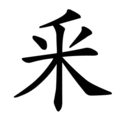Top Qs
Timeline
Chat
Perspective
釆
From Wiktionary, the free dictionary
Remove ads
| ||||||||
| ||||||||
Translingual
Han character
釆 (Kangxi radical 165, 釆+0, 7 strokes, cangjie input 竹火木 (HFD) or 難竹火木 (XHFD), four-corner 20909, composition ⿱丿米 or ⿻禾丷)
- Kangxi radical #165, ⾤.
- Shuowen Jiezi radical №17
Derived characters
References
- Kangxi Dictionary: page 1290, character 4
- Dai Kanwa Jiten: character 40115
- Dae Jaweon: page 1790, character 8
- Hanyu Da Zidian (first edition): volume 6, page 3898, character 1
- Unihan data for U+91C6
Remove ads
Chinese
Glyph origin
Pictogram (象形). According to Shuowen Jiezi, it's an animal paw with spread toes, hence the character is linked to 蹯.
According to Zhang Shichao (張世超), it's the representation of a wooden plough (力) and some seeds to convey the concept of "disseminate, spread", hence the character is linked to 播.
Etymology
Exopassive of 辨 (OC *brenʔ, “to divide, distinguish, discriminate”); possibly in the same word-family as another exopassive 瓣 (OC *breːns, “what is divided”). These three thus may be related to either 班 (OC *praːn, “to distribute → to arrange, classify → class, group”) or Mizo pʰel (“to split, cut in halves”) (with medial *-r- dropped after labial initials according to Mizo phonotactics) (Schuessler, 2007).
Pronunciation
- Mandarin
- (Standard Chinese)+
- Hanyu Pinyin: biàn
- Zhuyin: ㄅㄧㄢˋ
- Tongyong Pinyin: biàn
- Wade–Giles: pien4
- Yale: byàn
- Gwoyeu Romatzyh: biann
- Palladius: бянь (bjanʹ)
- Sinological IPA (key): /pi̯ɛn⁵¹/
- (Standard Chinese)+
- Cantonese
- (Standard Cantonese, Guangzhou–Hong Kong)
- Jyutping: bin6
- Yale: bihn
- Cantonese Pinyin: bin6
- Guangdong Romanization: bin6
- Sinological IPA (key): /piːn²²/
- (Standard Cantonese, Guangzhou–Hong Kong)
- Hakka
- (Sixian, incl. Miaoli and Neipu)
- Pha̍k-fa-sṳ: phien
- Hakka Romanization System: pien
- Hagfa Pinyim: pian4
- Sinological IPA: /pʰi̯en⁵⁵/
- (Sixian, incl. Miaoli and Neipu)
- Southern Min
- Middle Chinese: beanH
Definitions
釆
- to distinguish; to discriminate
Remove ads
Japanese
Kanji
釆
Readings
Korean
Hanja
釆 • (byeon) (hangeul 변, revised byeon, McCune–Reischauer pyŏn, Yale pyen)
- distinguish
- KangXi radical 165
Vietnamese
Han character
釆: Hán Nôm readings: biện, thái, trảy, trẩy
- This term needs a translation to English. Please help out and add a translation, then remove the text
{{rfdef}}.
Wikiwand - on
Seamless Wikipedia browsing. On steroids.
Remove ads




